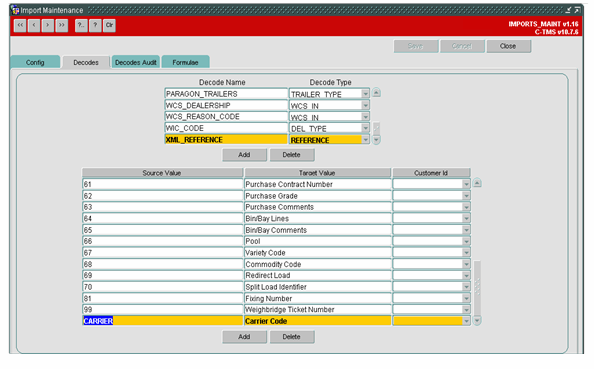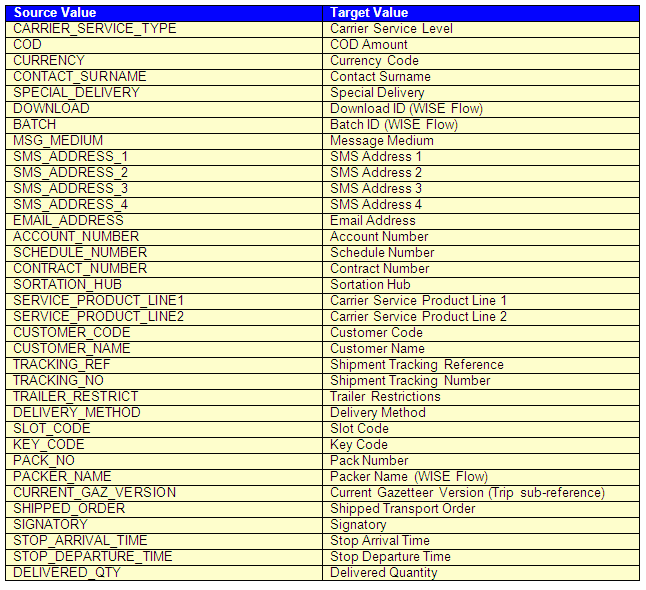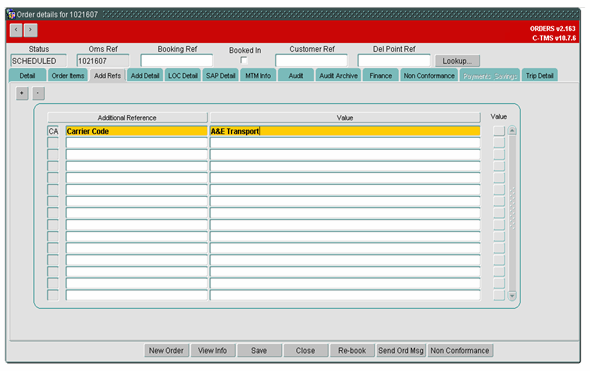291614: Difference between revisions
Middletong (talk | contribs) No edit summary |
Middletong (talk | contribs) No edit summary |
||
| Line 137: | Line 137: | ||
[[Image:291614_3.png]] | [[Image:291614_3.png]] | ||
'''N.B. It will be used to store the ‘Account Number’, ‘Schedule Number’ and ‘Contract Number’ for the customer at the despatching location of the trip for the carrier where these values are obtained at the appropriate combination of carrier/customer/location.''' | |||
‘Sortation Hub’, ‘Carrier Service Type’, ‘Carrier Service Product Line 1’, ‘Carrier Service Product Line 2’, Customer Code’ and ‘Customer Name’ all refer to the order. | |||
‘Shipment Tracking Reference’ and ‘Shipment Tracking Number’ refer to the shipment tracking data and may be stored here because the ‘Shipment ID’ is stored for each order. | |||
'''N.B. The OMS reference for each transport order in the shipment will be included in the order sub-references section.''' | |||
The decoded <SUB_REF_IDENTIFIER> data and its corresponding extracted <SUB_REFERENCE> data will be stored within C-TMS on the table called ‘SCH_ORD_REFERENCE’. | |||
The new data once imported into C-TMS will be visible from the ‘ORDERS’ form on the | |||
‘Add Refs’ (‘Additional References’) tab: | |||
[[Image:291614_4.png]] | |||
'''N.B. No code changes are required for this portion of the RIO.''' | |||
===Trip Sub Refs Data=== | |||
A new section called ‘TRIP_SUB_REFS’ will be added to the new v2.24 of the ‘TripOrder’ XML format in the ‘TRIP_DETAIL’ section. | |||
This section will be included once per trip and will have the same structure as the order sub-references section that exists already. | |||
'''N.B. It will be used to store the ‘Meter Number’ for the cost centre of the trip for use in the generation of the electronic carrier manifests by DHL Link.''' | |||
Revision as of 11:05, 15 October 2012
![]()
DHL C-TMS
C-TMS Interface Modifications
FUNCTIONAL SPECIFICATION - 10.7
18/11/11 - 2.0
Reference: FS 291614 NW-8L8JRN
FUNCTIONAL OVERVIEW
Client Requirement
Project Rigel - Modifications to XML Order Import (see section 4.1.1 in the System Design Document).
Solution
A new version of the standard XSD will be required to accommodate the new fields being sent into C-TMS.
It is currently assumed that the generic CSV order import will suffice for all of the customers not using the new XML format that requires the additional information for the carrier label production etc.
It is expected that most of the additional fields will be included within the ‘Order Sub Refs’ section of the XML.
These ‘Order Sub Refs’ will be defined on the ‘Decode’ tab in the ‘Import Maintenance’ screen.
The following items are to be included in the ‘Order Sub Refs’:
- Carrier Service Level
- COD Amount
- Currency Code
- Contact Surname
- Special Delivery (i.e. Saturday Delivery)
- Download ID (WISE Flow)
- Batch ID (WISE Flow)
- Message Medium
- SMS Address 1
- SMS Address 2
- SMS Address 3
- SMS Address 4
- Email Address
- Account Number
- Schedule Number
- Contract Number
- Sortation Hub
- Carrier Service Product Line 1
- Carrier Service Product Line 2
- Tracking Reference
- Tracking Number
- Trailer Restrictions
- Delivery Method
- Slot Code
- Key Code
- Pack No
- Packer Name (WISE Flow)
- Current Gazetteer Version
- Shipped Transport Order
A new section will be added to the XSD to allow the input of the additional hazardous information.
The hazardous information will be at DU level so data can be entered for each order line.
The following information will be included in the hazardous information:
- Hazardous Flag
- UN Number
- Hazardous Quantity
- Hazardous Description
Sub-references will be available at the trip and trip stop levels.
The ‘Order Header’ section will include the following customer information:
- Customer ID
- Customer Name
The ‘Order Header Address’ and ‘Stop Detail’ sections will include a new ‘Country Name’ item.
Scope
This change will be applied to system version 10.7.0.
FUNCTIONAL DESCRIPTION
TripOrder XML
The current XML order import is based on the format defined in the TripOrder.xsd (Appendix A for the XSD versions).
The new version 2.23 of the XSD has been created containing the following additional items:
- STOP_ETA_DATE
- STOP_ETA_AT_DATE
- ADDRESS_ORDER_COMMENTS
- ADDRESS_CONTACT_TYPE
- ACTUAL_FOOTPRINT
- HAZARDOUS
- UN_NUMBER
- HAZARDOUS_QTY
- HAZARDOUS_DESCRIPTION
- PALLET_ID
The new version 2.24 of the XSD will be created containing the following additional items:
- ADDRESS_COUNTRY_NAME
- STOP_COUNTRY_NAME
- CUSTOMER_ID
- CUSTOMER_NAME
- DIM_WEIGHT
- ACTUAL_DIM_WEIGHT
- DU_DESCRIPTION
- DU_CATEGORY
- UNIT_TRACKING_REF
- UNIT_TRACKING_NO
‘ADDRESS_COUNTRY_NAME’ and ‘STOP_COUNTRY_NAME’ will store the country name of the address in the ‘ORDER_HEADER_ADDRESS’ and ‘STOP_ADDRESS’ sections respectively.
‘CUSTOMER_ID’ and ‘CUSTOMER_NAME’ will store the customer information of the transport order in the ‘ORDER_HEADER’ section.
‘DIM_WEIGHT’ and ‘ACTUAL_DIM_WEIGHT’ will store the volumetric weight and they will be added to the ‘ORDER_DETAIL’ section.
‘DU_DESCRIPTION’ and ‘DU_CATEGORY’ will store the despatch unit data and they will be added to the ‘ORDER_DETAIL’ section.
‘UNIT_TRACKING_REF’ and ’UNIT_TRACKING_NO’ will store the tracking number data for the despatch unit and they will be added to the ‘ORDER_DETAIL’ section in a new repeating subsection called ‘TRACKING_REFS/TRACKING_REF’.
N.B. Multiple tracking references and number may be included for the quantity of despatch units, therefore, the tracking reference tags will be repeated in the ‘ORDER_DETAIL’ section for the despatch unit.
N.B. The ‘Customer Reference’ of the order will be stored in the <SO_REF> tag and the ‘Delivery Point Reference of the order will be stored in the <PO_REF> tag.
We will need to receive both a delivery type (as now) and an addition service level field that will need to be stored at order level rather than just in sub references to be used in determining the time windows (if not already populated by the external system) using the wholesale template as part of the new scheduling process.
Order Sub Refs Data
Most of the new data to be provided for the Rigel project as part of the XML order import will be passed through the existing optional <ORDER_SUB_REFS> section of the XSD.
The data provided against the <SUB_REF_IDENTIFIER> tag in the XML has to be decoded via the standard import decode table using a ‘Decode Name’ of ‘XML_REFERENCE’.
The data will be maintained on the ‘Import Maintenance’ form as follows:
The following is a list of possible decoded values (which need to be agreed with DHL Link) which can be used for the new data to be provided in the <SUB_REF_IDENTIFIER> tag:
N.B. It will be used to store the ‘Account Number’, ‘Schedule Number’ and ‘Contract Number’ for the customer at the despatching location of the trip for the carrier where these values are obtained at the appropriate combination of carrier/customer/location.
‘Sortation Hub’, ‘Carrier Service Type’, ‘Carrier Service Product Line 1’, ‘Carrier Service Product Line 2’, Customer Code’ and ‘Customer Name’ all refer to the order.
‘Shipment Tracking Reference’ and ‘Shipment Tracking Number’ refer to the shipment tracking data and may be stored here because the ‘Shipment ID’ is stored for each order.
N.B. The OMS reference for each transport order in the shipment will be included in the order sub-references section.
The decoded <SUB_REF_IDENTIFIER> data and its corresponding extracted <SUB_REFERENCE> data will be stored within C-TMS on the table called ‘SCH_ORD_REFERENCE’.
The new data once imported into C-TMS will be visible from the ‘ORDERS’ form on the ‘Add Refs’ (‘Additional References’) tab:
N.B. No code changes are required for this portion of the RIO.
Trip Sub Refs Data
A new section called ‘TRIP_SUB_REFS’ will be added to the new v2.24 of the ‘TripOrder’ XML format in the ‘TRIP_DETAIL’ section.
This section will be included once per trip and will have the same structure as the order sub-references section that exists already.
N.B. It will be used to store the ‘Meter Number’ for the cost centre of the trip for use in the generation of the electronic carrier manifests by DHL Link.



